Stargates of Ancient Egypt!
Oct 03, 2022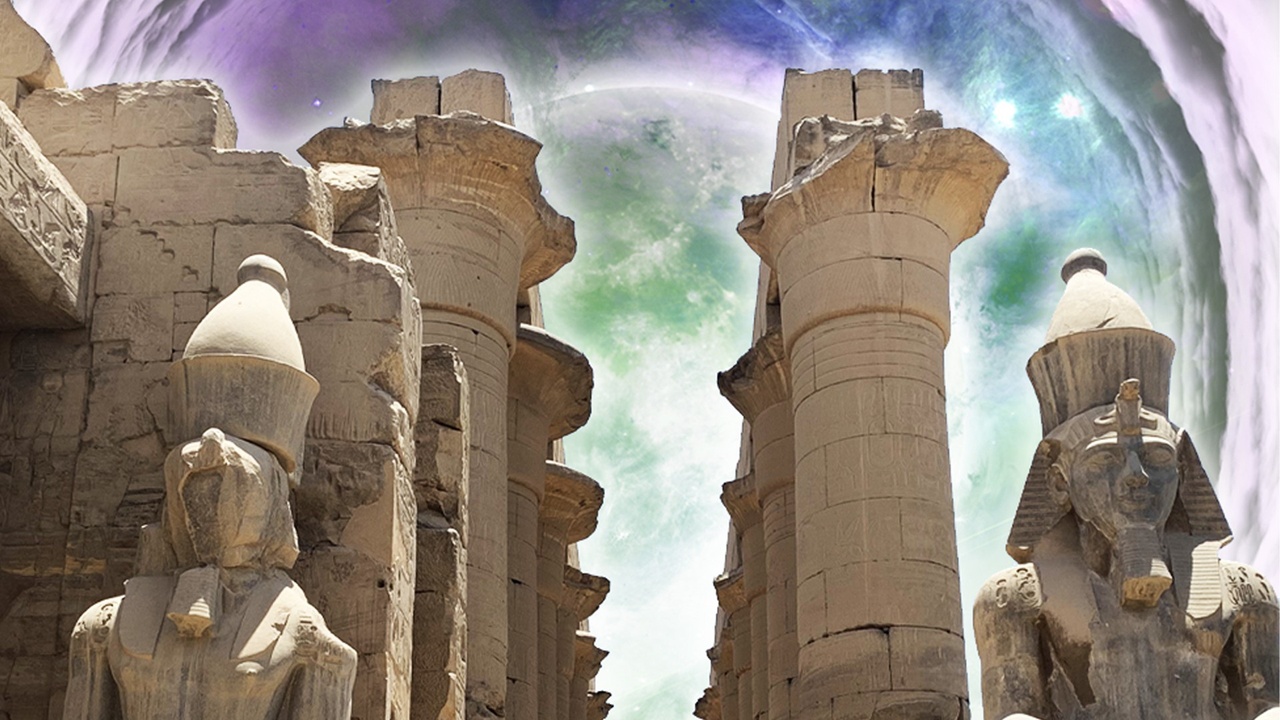
Autumn begins to settle into northeastern Ohio, more specifically the Cleveland area, with crisp air and overcast skies to look forward to until snow and the bitter chill of winter’s kiss encompasses The Land. While the frigid air may cause most to look past winter to the spring beyond, I’m especially looking forward to February 7. Why? That’s because I will once again be stepping off an airplane in Cairo, Egypt where I will enjoy the warm blanket of the desert heat for the Stargates of Ancient Egypt Tour. At that time of year, the temperatures will be an ideal 75-80 degrees. What do we expect to find?
In June 2021, I was sitting next to Mohamed Ibrahim on a flight from Cairo to Aswan as we embarked on the middle leg of the Return of the Kheper Cycle Tour, a tour that celebrated the dawn of a new cycle of life with exclusive two-hour access for just our group inside the Great Pyramid of Giza on the summer solstice. It was absolutely amazing. In my hand as I sat in my airplane seat was a copy of Christopher Dunn’s book Lost Technologies of Ancient Egypt. Mohamed and I began to talk, and I revealed to him that, like Dunn, my father was a machinist, which launched us into a discussion about some of the greater mysteries of ancient Egypt and the type of technology they likely had at their disposal to create many of their mesmerizing structures. As our flight neared Aswan, Mohamed said, “I would like to do a tour with you. Let’s talk after this one.” Thus, was established the kernel of what has now become the Stargates of Ancient Egypt Tour.

What’s a stargate? When we think of the word “stargate” we usually think of the 1994 movie of the same name or the various Stargate television shows that have been produced. Yes, the idea is to use some sort of portal to travel from one point in the universe to another – or even just across our own planet somewhere.
In modern times, theories concerning wormholes were first introduced to the scientific community in the early Twentieth Century, although the nomenclature was different. Albert Einstein’s theory of general relatively had not been immediately embraced, and Austrian physicist Ludwig Flamm had been reviewing another physicist’s solution to Einstein’s equations when he realized alternative solutions were possible. In 1916, Flamm proposed a “white hole,” or a black hole that has been, theoretically, reversed. With this possibility available, a space-time conduit could connect the entrances to black holes and white holes.
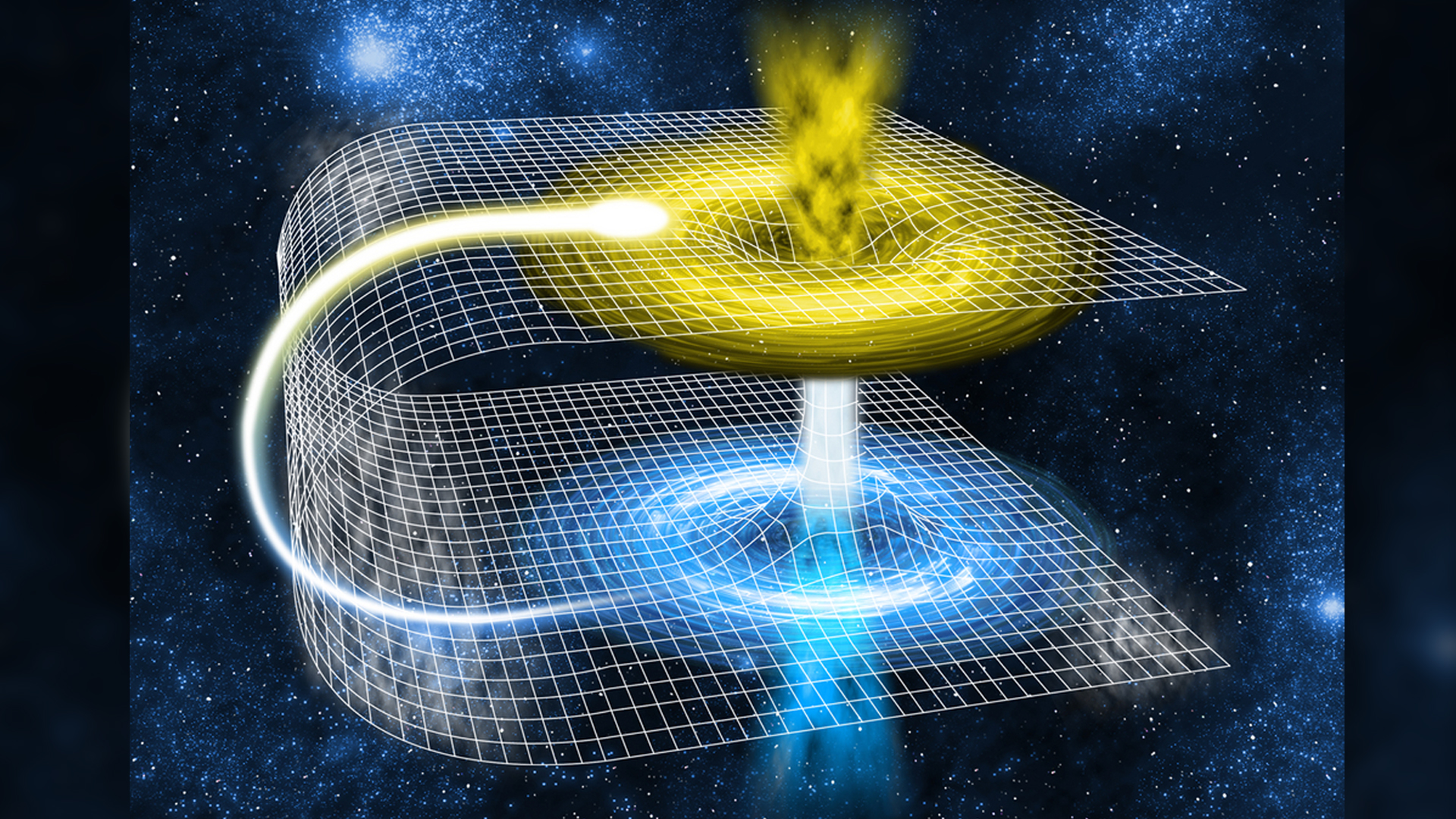
By 1935, the theory of general relativity was firmly entrenched, and Einstein, along with physicist Nathan Rosen, used the theory to elaborate on Flamm’s idea to propose the idea that “bridges” crossed through space-time. If one could bend space and time, these bridges could connect two different points to create shortcuts across the cosmos. This would greatly reduce the amount of time and distance between these points, making it a much more effective means of travel through space. When we refer to wormholes today, we are referring to these Einstein-Rosen bridges, and it is believed that many of these entrances which can be readily accessed by intelligent life are our stargates.
So how does that apply to our exploration of ancient Egypt in February? I don’t want to give it all away, but allow me to give you a little taste while you sip your favorite autumn brew.
Hatshepsut’s Temple
The layout of Hatshepsut’s Mortuary Temple is absolutely fascinating, and if I had any influence into the design work of a stargate in an upcoming blockbuster movie, this temple would be my basis for it. First, we have to consider the long staircase one must climb up to the temple which leads straight back to the Holy of Holies. Alongside this beautiful staircase are two carved falcons which are the animal representation of the God (or neter) Horus; however, these falcons do not appear to be the original animals depicted on these sculptures. A closer examination of the stonework from these statues up alongside the staircase reveals the tail of a snake, the snake being an ancient representation of energy. It’s difficult to say what kind of snake these statues may have originally have been, but one theory is that they were originally cobras. In any case, it’s the energy which concerns us, and that representation of energy leads straight up into temple and is pointed back at the Holy of Holies.
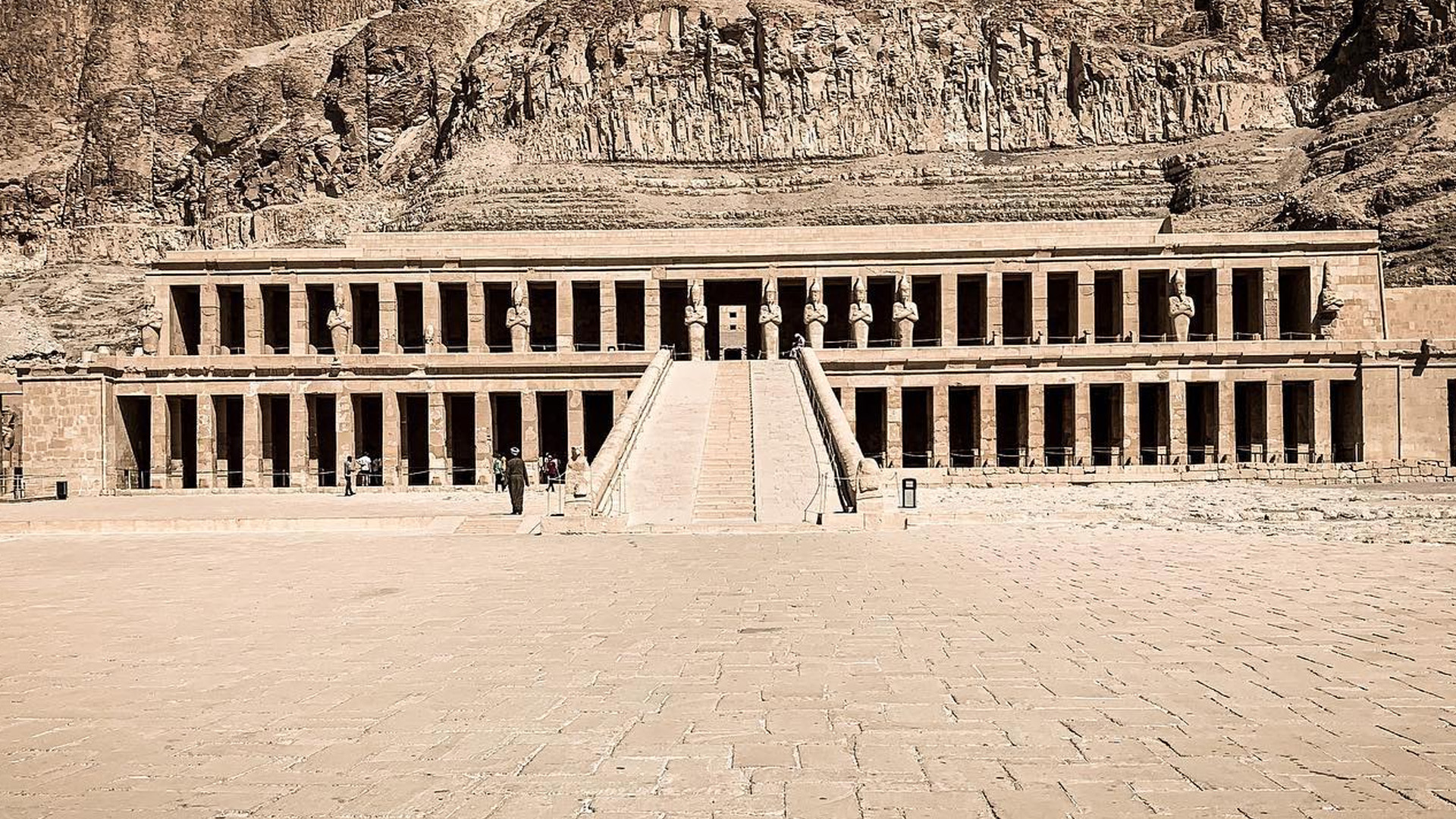
If one looks off to the left of the temple complex there is a platform with a ruined collection of blocks atop it which is inaccessible to the public. These ruins are actually the last vestiges of a small pyramid. What is a pyramid doing here? If one ascribes to the idea that Christopher Dunn has put forth that many of these pyramids were once some sort of power plant or machine, then this pyramid off to the side may have acted like a generator we see standing off to the side of so many large buildings. But a generator for what?
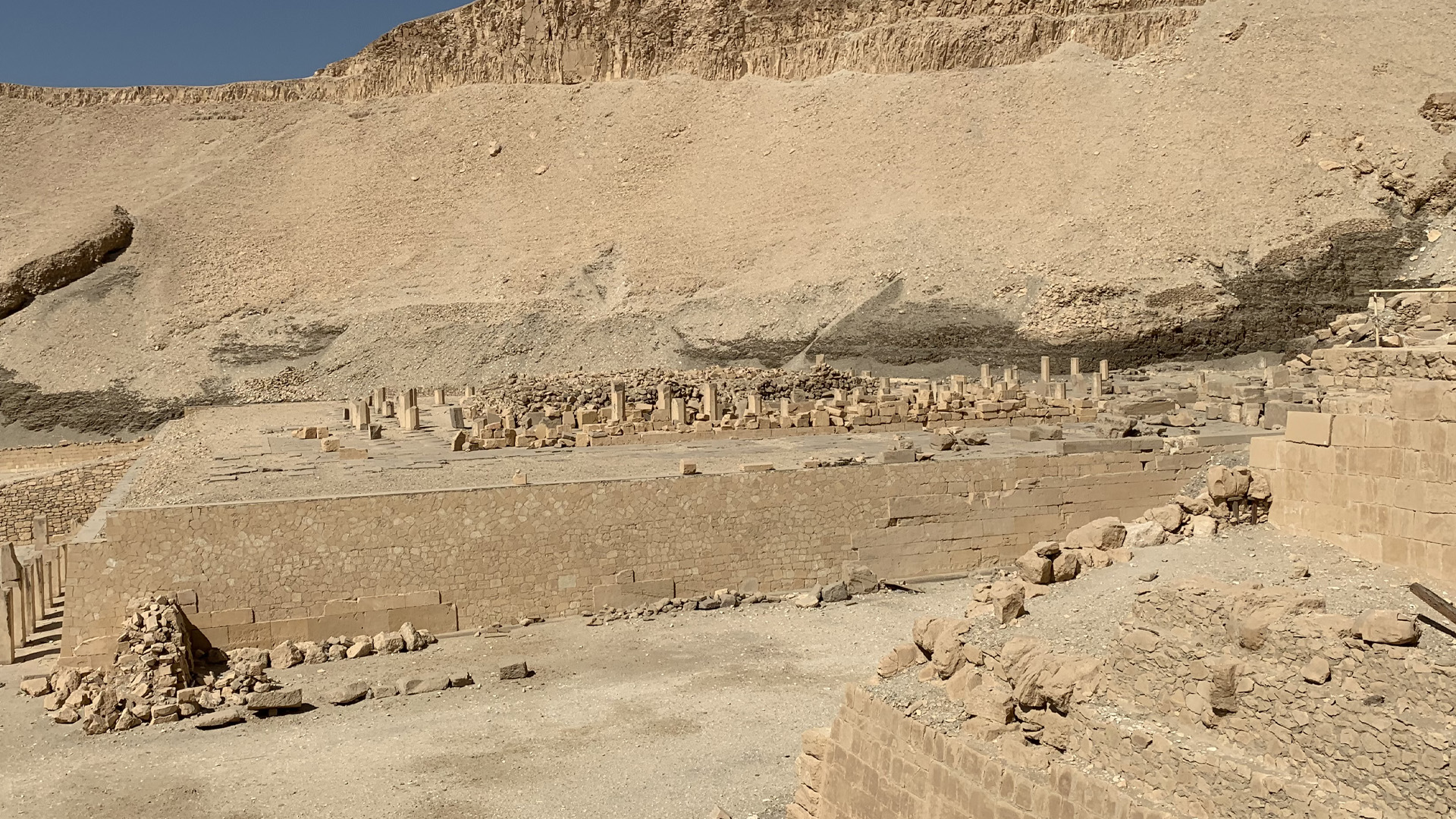
We have a picture starting to take shape for us with the symbolism of energy alongside the stairs and a possible power generator off to the side, but it becomes more blatantly obvious once one has traversed up the stairs. On the left side of the doorway into the inner courtyard we find the hieroglyphs designating “great stargate.” As one ventures further inside toward the Holy of Holies, we also find hieroglyphs designating “stargate” alongside the entrance doorway. Humorously (at least to me), is a photo I took of this stargate designation directly above a sign telling tour guides not to explain anything inside the entranceway to the Holy of Holies. Pay no attention to the man behind the curtain. Wink, wink.
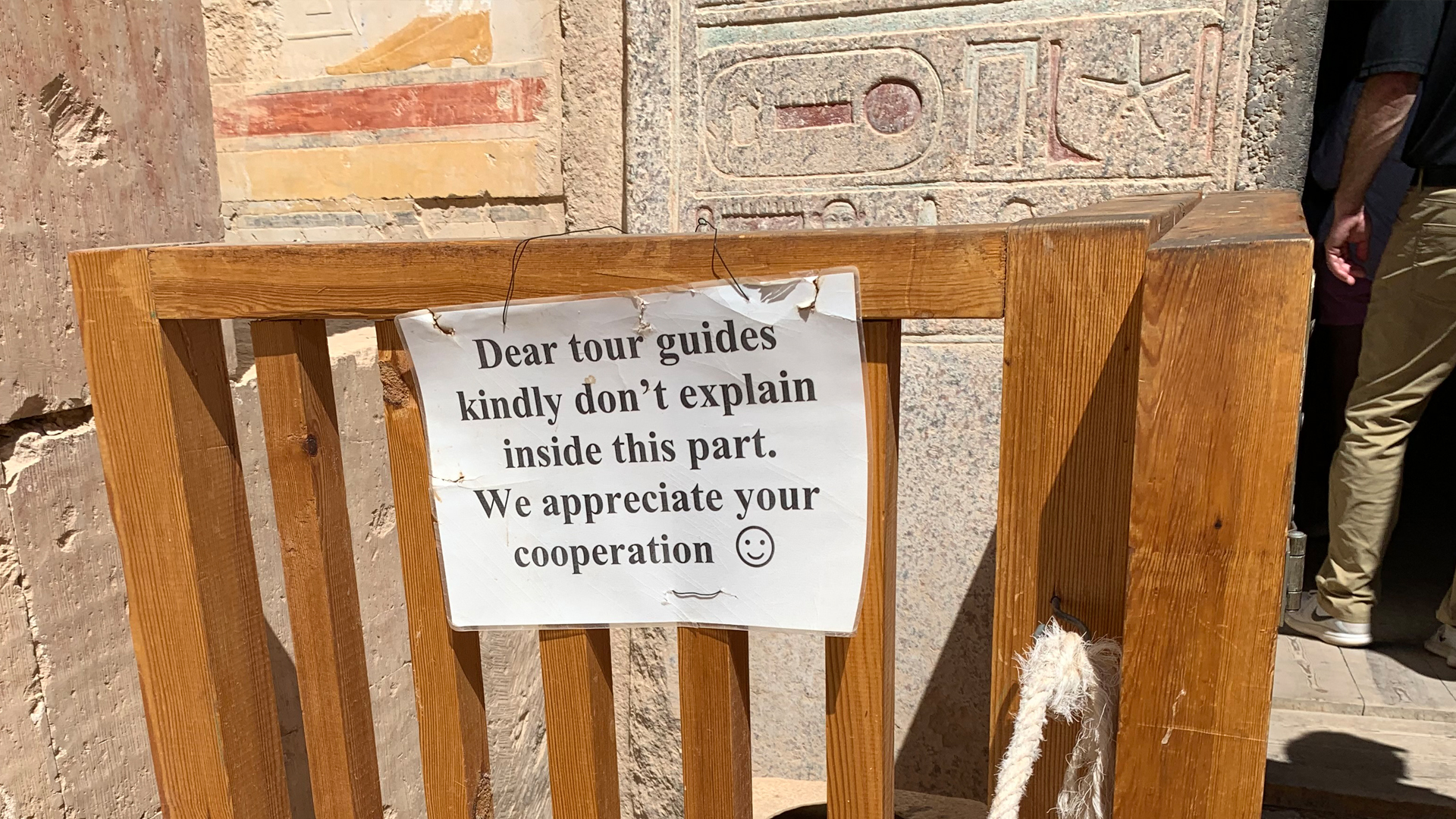
The public does not have access to the Holies of Holies, the innermost sanctum of Hatshepsut’s temple. There is a gate before the chamber with two guards posted, but for a tip they will lean inside and take a quick photo for you. Why can’t one get inside? What’s so special to deem this area off limits? If one gets there early enough, as my good friend and esoteric researcher, Jonny Enoch, did, you can grease come palms with some hard cash (I couldn’t tell you how much) and gain access for a brief moment. What’s inside is fascinating. On one of the walls is a unique cartouche with a field of stars within it, a blatant representation of access by the king (Hatsheptsut, although female, was still considered a king, not queen) having access to the stars – a stargate.
Abydos
Seti’s Temple at Abydos has so many amazing things going on with it, but most people seem to only be interested in one feature: the hieroglyphs that look like modern machinery. True, what we see looks like objects today we would construe as an airplane, a helicopter, a tank, and more. Deterrents of this idea state that old hieroglyphs were plastered over while new hieroglyphs were chiseled in, and then the plaster fell out over time leaving us with a combination of overlapping hieroglyphs. That’s an interesting hypothesis, and some of it may certainly have been plastered over, but if that were entirely true then we would see similar strange “modern-looking” hieroglyphs elsewhere, and we just don’t. It seems these images were still intentionally created, and Mohamed Ibrahim does a much better job of explaining this in 2021’s Egypt Travel Blog here on the Connected Universe Portal (can also be found in the Ancient Egypt course as well). This controversy, however, has nothing to do with stargates.
As one ventures inside Seti’s Temple, we find a large chamber with friezes depicting the ceremony of the djed pillar, a yearly celebration of the renewal of energies in Egypt. The djed pillar was a symbol of the backbone of Egypt, Osiris’s backbone, and what’s fascinating is that while we see many depictions of the djed pillar, trinkets and figurines carved into the shape of a djed pillar, even depicted as columns at Saqqara, no djed pillar had yet to be unearthed to our knowledge to show us what they truly looked like. This was an important part of Egyptian culture, and within this chamber depicting the celebration of renewal we find three smaller chambers labeled as stargates. With Osiris we have a story of ascension, and while we see a story of the ascension of the djed pillar in the chamber outside the stargate chambers, the function of a stargate itself is to ascend to some other location or world.
Other fascinating aspects of the Abydos complex include one of the largest known lists of Egyptian kings, which fails to include several famous kings such as Akhenaten and Tutankhamen, the archaic and far older Osirion behind the temple, the mysterious depiction of the Flower of Life symbol completely out of time and place, intricately placed light shafts, and more. The Abydos complex is a very important one, and that it may have once housed stargates makes it all the more fascinating.
These are just a couple examples of stargates scattered throughout the ancient structures of Egypt, more of which we’ll be exploring during our Stargates of Ancient Egypt Tour in February. We also see the symbolism depicted at Karnak and other temples, and there are fascinating stories about stargate activity coming out of Zawyet El Aryan, the remains of a pyramid complex near Dashur closed off by the Egyptian military and referred to by some as “Egypt’s Area 51.”
More about this topic can also be explored in the Connecting the Universe class on the same subject that was streamed live on YouTube earlier this year as an example of what to expect in our weekly classes on the Connected Universe Portal – as well as on the tour!
Interested in learning more about the Connected Universe and gaining access to exclusive, behind-the-scenes content?
Stay connected with news and updates!
Get all the latest news, updates, and insights from author and researcher Mike Ricksecker and the Connected Universe community! Don't worry, your information will not be shared.
We hate SPAM. We will never sell your information, for any reason.






